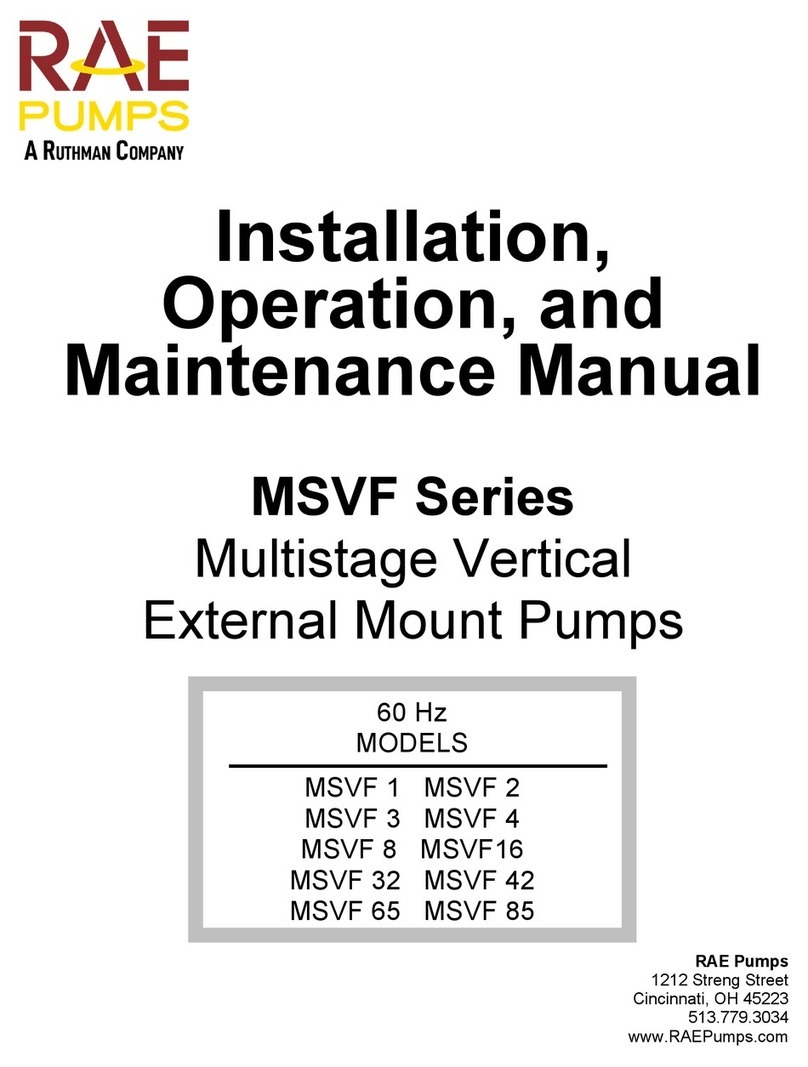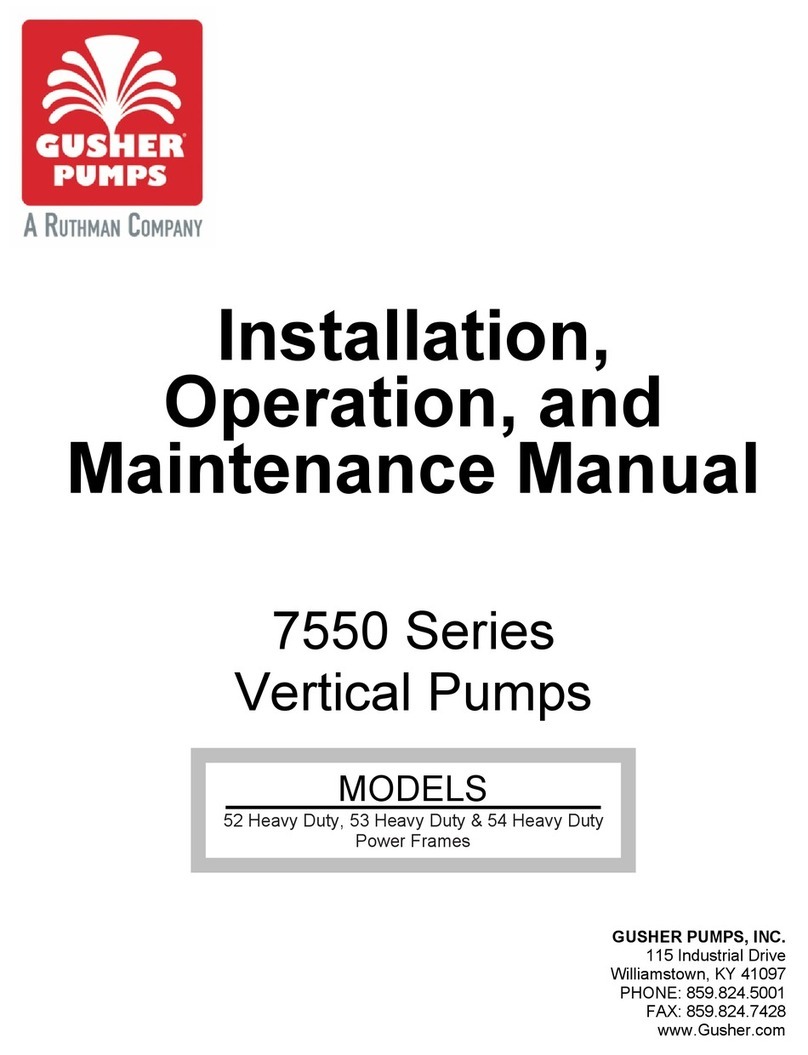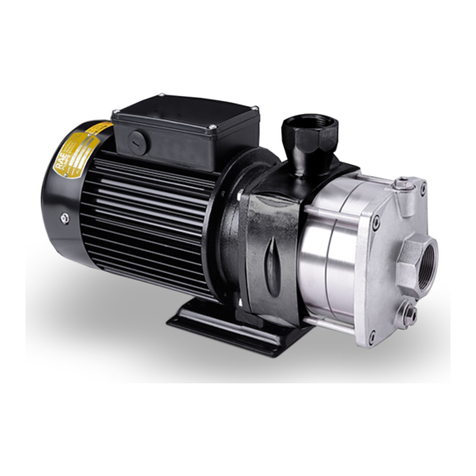
6
SECTION II - ROTATING
ELEMENT:
Removal and Replacement
1. Remove Chair with Motor by the procedure out-
lined in the preceding SECTION I, 7600 Series
REPAIRS.
2. Screw Steel Eyebolt into Tapped Hold Provided
on Shaft. 1 .) 1/2-13 on 52 HD; 2.) 5/8-11 on 53
HD; 3.) 3/4-10 on 54 HD.
3. Hook hoist through eyebolt and lift Rotating Ele-
ment straight up.
4. Remove eyebolt and screw into stand-by unit.
a. If you do not have a stand-by unit and repair
has to be made, proceed as follows:
1. Get Serial No. of Unit.
2. Call Gusher Pumps, Inc. direct or the
Gusher Representative in your area with
list of parts required to repair your unit.
Many of the parts for the 7500 and 7600
Series are interchangeable, so parts are
normally in stock. Allow approximately 1
week to 10 days for processing of order.
For complete Parts List, see Pages 8 thru
10.
5. Lower replacement Unit straight down into posi-
tion, taking care when lowering into opening to
avoid all contact with Housing Support (#7a) so
as not to damage “0”Ring (#15a).
6. Replace Chair with Motor as outlined in SEC-
TION I, 7600 Series REPAIRS.
SECTION III - STATIONARY
ELEMENT
Removal and Replacement
One of the most advantageous aspects of the 7600 Series
is that this portion of the Unit rarely has to be replaced.
However, in the event such exceptional replacement is
necessary, the element is replaced as follows:
1. Remove Chair with Motor as outlined in SEC-
TION I, 7600 Series REPAIR.
2. Remove Rotating Element as detailed in SEC-
TION II, 7600 Series, REPAIR.
3. Remove four (4) Mounting Plate Hold-down
Screws.
4. Disconnect discharge piping.
5. Secure rigging and lift straight up.
6. Make repairs. SEE Page No. 8 thru 10 for parts
list.
7. Lower Stationary Element into position.
8. Make discharge pipe connections.
9. Replace Rotating Element. SEE SECTION II,
7600 Series REPAIRS.
10. Replace Chair with Motor. SEE SECTION I, 7600
Series REPAIRS.
SECTION IV - ROTATING
ELEMENT: Repairs
1. Remove Rotating Element by procedure out-
lined in SECTION II, 7600 Series REPAIRS.
2. Remove Impeller Retaining Hardware.
3. Slide Impeller (#12) off Shaft (#I).
a. It may be necessary to place pry bar between
Impeller back shroud and Stem (#7).
4. Remove Impeller Drive Key (#19) and tape to hub
of Impeller so it will not get lost.
5. Loosen Set Screws in Slinger (#8).
6. Remove Screws (#45) and slide Bearing Hous-
ing and Shaft Assembly out of Inner Stem (#7).
7. Remove Throttle Bushing (#lo) from Stem (#7).
8. Remove Adjusting Screws (#55) and Locking
Screw (#57).
9. Slide Ball Bearing Retainer (#2) off Shaft (#I).
10. Place the Ball Bearing Housing, Shaft Assembly
in a vertical position with Shaft (#I) down. By lift-
ing the Unit and dropping it on a block of wood,
tap Shaft (#I) with Ball Bearings (#6) and (#4) out
of Ball Bearing Housing (#5). Inspect Oil Seal
(#22) and replace if worn or damaged.
11. Remove Lock Nut (#3). Tap Thrust Bearing (#6) off
Shaft (#I). Slide telescoping Ball Bearing Hous-
ing (#5a) off Shaft (#I). Inspect Oil Seal (#21) and
replace if worn or damaged. Tap Grease/Radial
Bearing Retainer (#6) off Shaft (#I). Tap Radial
Bearing (#4) off Shaft (#I).
12 To reassemble, reverse procedure.
a. Remember to replace Telescoping Ball Bear-
ing Housing (#5a) on Shaft before installing
Ball Bearing (#6).
13. Ball Bearing Installation:
a. Bearing installation should take place under
conditions of cleanliness consistent with the
precision of the product involved. All tables
and tools must be clean and free from dirt or
other foreign matter that could end up in the
bearing.
b. When a bearing is installed, the mount-
ing force should be applied against the
race which is being press-fitted. A bearing
should never be forced onto a shaft by pres-
sure or hammer blows applied to outer ring,
nor should the bearing be press-fitted into a
housing by force applied to the inner ring.


































